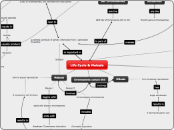Life Cycle & Meiosis
Meiosis
form of sexual reproduction
2 consecutive cell divisions
Meiosis I
starts with bivalent chromosomes
Anaphase: Chromosome disjunction
2 haploid daugher cells
Meiosis II
no homologous chromosomes
Chromatid disjunction
4 haploid daugheter cells
gurantees continuity of genetic information from 1 generation to another
Subtopic
Mitosis
form of asexual reproduction
single cell division
2 identical daughter cels
Main topic
Chromosomes: contain DNA
The Chromosome Complement
Sex Chromosomes
23rd Pair of Chromosome (XX or XY)
Autosomes
First 22 pairs of chromosomes
Gametes
Diploid
2 sets of chromosomes; one inherited from each parent
Chromosomal Nondisjunction
Trisomics
Down Syndrome
Monosomics
Speciation
Polyploidy
State of having more than 2 sets of chromosomes
May result in new species
Unreduced gametes
Hybrids
Tetraploid
Examples: Tragopogon & Triticum
Adaptive Radiation
development of new species from common ancestor due to adaptations to different environments
Energy Flow in Ecosystems
Ecosystem
group of plants & animals interconncected by energy and mineral flow
Living Organisms
Produceers
productivity
Primary Prodcutivity
Net Primary Productivity=Gross primary productivity - plant respiration
Consumers
Primary
Secondary
Tertiary
Detritivores
Species Interactions
Mutualism
limits geographical distribution
temperature
precipitaton
competition
predators and pathogens
soil type
Resource Partitioning
slight variations in niche that allow species to coexist
Predation
Competition
Population Regulation
Carrying Capacity
the maximum individuals of a population that an environment's resources can support
Biotic Potetial
Factors that promote population growth
Rate of reproduction
ability to withstand adverse conditions
defense mechanisms
Environmental Resistance
Factors that oppose population growth
Diseases
Predations & Pathogens
Insufficient food
Competition
Emmigration
Adverse Weather Conditions
Annual Growth Rate
BR - DR / 10
